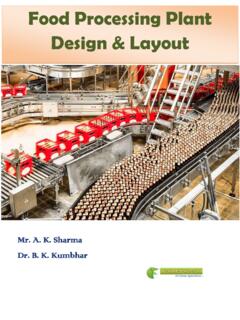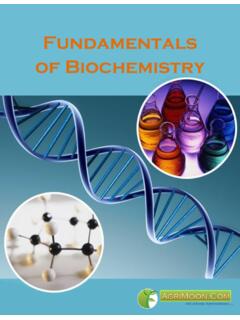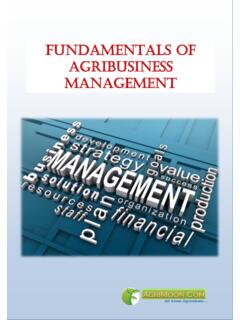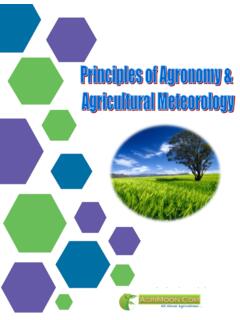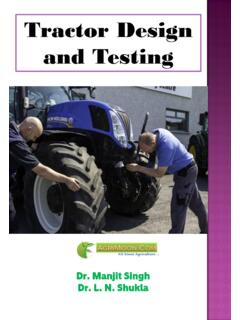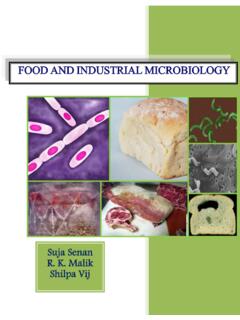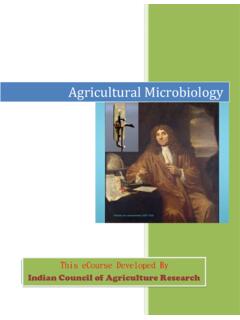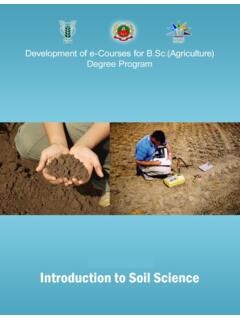Transcription of PLANT BIOTECHNOLOGY - AgriMoon
1 ICAR eCourse PRINCIPLES OF PLANT BIOTECHNOLOGY Index SN Lecture Name Page No 1. Concepts of BIOTECHNOLOGY 1-16 2. Tissue culture and its history 17-29 3. Scope and importance in crop improvement 30-39 4. Totipotency and Morphogenesis 40-56 5. Nutritional requirements 57-70 6. Techniques of in vitro cultures 71-87 7. Micropropagation 88-99 8. Haploid production and uses 100-110 9. Ovule culture 111-114 10. Ovary and embryo culture 115-124 11. Test tube fertilization 125-128 12. Endosperm culture 129-133 13. Factors influencing morphogenesis 134-137 14. Applications and achievements 138-150 15. Somaclonal variation and crop improvement 151-160 16. Somatic embryogenesis 161-175 17. Protoplast isolation 176-193 18. Products of somatic hybrids and cybrids 194-201 19. genetic engineering in plants 202-220 20. Enzymes used in genetic Engineering 221-229 21. Vectors: The carriers of DNA molecules 230-246 22. Gene cloning 247-250 23. Gene delivery methods in plants 251-266 24.
2 Transgenic plants and their applications 267-284 25. Blotting techniques 285-301 26. DNA finger printing 302-309 27. DNA markers in PLANT genome analysis 310-331 28. QTL mapping 332-339 29. Marker assisted selection and Crop improvement 340-345 Concepts of BIOTECHNOLOGY The term BIOTECHNOLOGY " was first coined in 1919 by Karl Ereky which means products are produced from raw materials with the aid of living organisms. BIOTECHNOLOGY is NOT new. Man has been manipulating living things to solve problems and improve his way of life for millennia. Early agriculture concentrated on producing food. plants and animals were selectively bred and microorganisms were used to make food items such as beverages, cheese and bread. The late eighteenth century and the beginning of the nineteenth century saw the advent of vaccinations, crop rotation involving leguminous crops and animal drawn machinery. The end of the nineteenth century was a milestone of biology.
3 Microorganisms were discovered, Mendel's work on genetics was accomplished and institutes for investigating fermentation and other microbial processes were established by Koch, Pasteur and Lister. BIOTECHNOLOGY at the beginning of the twentieth century began to bring industry and agriculture together. During World War I, fermentation processes were developed that produced acetone from starch and paint solvents for the rapidly growing automobile industry. Work in the 1930s was geared towards using surplus agricultural products to supply industry instead of imports or petrochemicals. The advent of World War II brought the manufacture of penicillin. The biotechnical focus moved to pharmaceuticals. The "cold war" years were dominated by work with microorganisms in preparation for biological warfare as well as antibiotics and fermentation processes (Goodman, 1987).
4 BIOTECHNOLOGY is currently being used in many areas including agriculture, bioremediation, food processing and energy production. DNA fingerprinting is becoming a common practice in forensics. Production of insulin and other medicines is accomplished through cloning of vectors that now carry the chosen gene. Immunoassays are used not only in medicine for drug level and pregnancy testing, but also by farmers to aid in detection of unsafe levels of pesticides, herbicides and toxins on crops and in animal products. These assays also provide rapid field tests for industrial chemicals in ground water, sediment and soil. In agriculture, genetic engineering is being used to produce plants that are resistant to insects, weeds and PLANT diseases. Lecture 011 Principles of PLANT BIOTECHNOLOGY - Bio means life and technology means the application of knowledge for practical use ie., the use of living organisms to make or improve a product.
5 Other definitions for the term BIOTECHNOLOGY The use of living organisms to solve problems or make useful products. The use of cells and biological molecules to solve problems or make useful products. Biological molecules include DNA, RNA and proteins. The commercial application of living organisms or their products, which involves the deliberate manipulation of their DNA molecules. Make a living cell to perform a specific task in a predictable and controllable way. BIOTECHNOLOGY has been described as "Janus-faced". This implies that there are two sides. On one side techniques allow DNA to be manipulated to move genes from one organism to another. On the other, it involves relatively new technologies whose consequences are untested and should be met with caution. Stages of BIOTECHNOLOGY development Ancient BIOTECHNOLOGY - 8000-4000 Early history as related to food and shelter; includes domestication Classical BIOTECHNOLOGY - 2000 ; 1800-1900 AD Built on ancient BIOTECHNOLOGY ; fermentation promoted food production and medicine 1900-1953: Genetics 1953 - 1976: DNA research, science explodes Modern BIOTECHNOLOGY - 1977 Manipulates genetic information in organism; genetic engineering BIOTECHNOLOGY is a collection of various technologies that enable us to improve crop yield and food quality in agriculture and to produce a broader array of products in industries.
6 2 Principles of PLANT Various technologies and their uses genetic Engineering (Recombinant DNA) Technology The use of cellular enzymes to manipulate DNA Transferring DNA between unrelated organisms Protein Engineering Technology Improve existing/create novel proteins to make useful products Antisense or RNAi Technology Block or decrease the production of certain proteins Cell and Tissue Culture Technology Grow cells/tissues under laboratory conditions to produce an entire organism, or to produce new products Bioinformatics Technology Computational analysis of biological data, , sequence analysis macromolecular structures, high-throughput profiling data analysis Functional Genomics (the -omics) 3 Principles of PLANT use of genome-wide, high-throughput approaches to determine the biological function of all of the genes and their products High-throughput technologies (the -omics) Transcriptomics ( microarray expression profiling) Proteomics ( structures/modifications/interactions of proteins) Proteins are responsible for an endless number of tasks within the cell.
7 The complete set of proteins in a cell can be referred to as its proteome and the study of protein structure and function and what every protein in the cell is doing is known as proteomics. The proteome is highly dynamic and it changes from time to time in response to different environmental stimuli. The goal of proteomics is to understand how the structure and function of proteins allow them to do what they do, what they interact with and how they contribute to life processes. Metabolomics ( metabolite profiling, chemical fingerprinting, flux analysis) Metabolomics is one of the newest omics sciences. The metabolome refers to the complete set of low molecular weight compounds in a sample. These compounds are the substrates and by products of enzymatic reactions and have a direct effect on the phenotype of the cell. Thus, metabolomics aims at determining a sample s profile of these compounds at a specified time under specific environmental conditions Transgenomics ( knock-out, knock-in, gene tagging, mutagenesis) Translational genomics 4 Principles of PLANT of BIOTECHNOLOGY & genomics 1.
8 Environmental BIOTECHNOLOGY A. Environmental monitoring Diagnosis of environmental problems via BIOTECHNOLOGY B. Waste management Bioremediation: the use of microbes to break down organic molecules or environmental pollutants. Phyto remediation: the use of plants to remove pollutants ( heavy metals) from the environment. C. Pollution prevention Renewable resources Biodegradable products Alternative energy sources 5 Principles of PLANT Medical BIOTECHNOLOGY A. Diagnostics B. Therapeutics C. Vaccines D. Medical research tools E. Human Genome Research 3. Agricultural BIOTECHNOLOGY A. Animal BIOTECHNOLOGY B. Crop BIOTECHNOLOGY C. Horticultural BIOTECHNOLOGY D. Tree BIOTECHNOLOGY E. Food processing 4. Evolutionary and ecological genomics Finding genes associated with ecological traits and evolutionary diversification. Common goals: health, productivity PLANT BIOTECHNOLOGY /Agricultural BIOTECHNOLOGY A process to produce a genetically modified PLANT by removing genetic information from an organism, manipulating it in the laboratory and then transferring it into a PLANT to change certain of its characteristics.
9 In Nutshell it s the manipulation of plants for the benefit of mankind The plants are mainly manipulated for two major objectives A. Crop improvement Herbicide tolerance (in use) Pest resistance (in use) Drought tolerance Nitrogen fixing ability Acidity and Salinity tolerance B. Nutritional value of crops Improving food quality and safety Healthier cooking oils by decreasing the conc. of saturated fatty acids in vegetable oils Functional foods: foods containing significant levels of biologically active components that impart health benefits 6 Principles of PLANT technologies applied in PLANT BIOTECHNOLOGY includes genetic engineering/ recombinant DNA technology Tissue culture Molecular breeding MAS Traditional PLANT breeding involves cross-breeding of similar plants to produce new varieties with different traits. But it takes many generations to achieve desired result.
10 By using various biotechnological tools, crop improvement can be achieved faster and it even facilitates to transfer genes from unrelated species genetic engineering Manipulation of genes is called genetic engineering or recombinant DNA technology. It removes gene(s) from one organism and either Transfers them to another Puts them back in the original with a different combination Various gene transfer techniques used in genetic engineering includes Agrobacterium mediated gene transfer: Desired trait is isolated from DNA of original organism, inserted into Agrobacterium, target PLANT is infected. Cells that accept the DNA are grown into plants with the new trait. Gene gun: DNA that codes for the desired trait is coated onto tiny particles of tungsten and fired into a group of PLANT cells. Cells that accept the DNA are grown into plants with the desired trait. Tissue culture Tissue culture manipulates cells, anthers, pollen grains, or other tissues; so they live for extended periods under laboratory conditions or become whole, living, growing organisms; genetically engineered cells may be converted into genetically engineered organisms through tissue culture.
